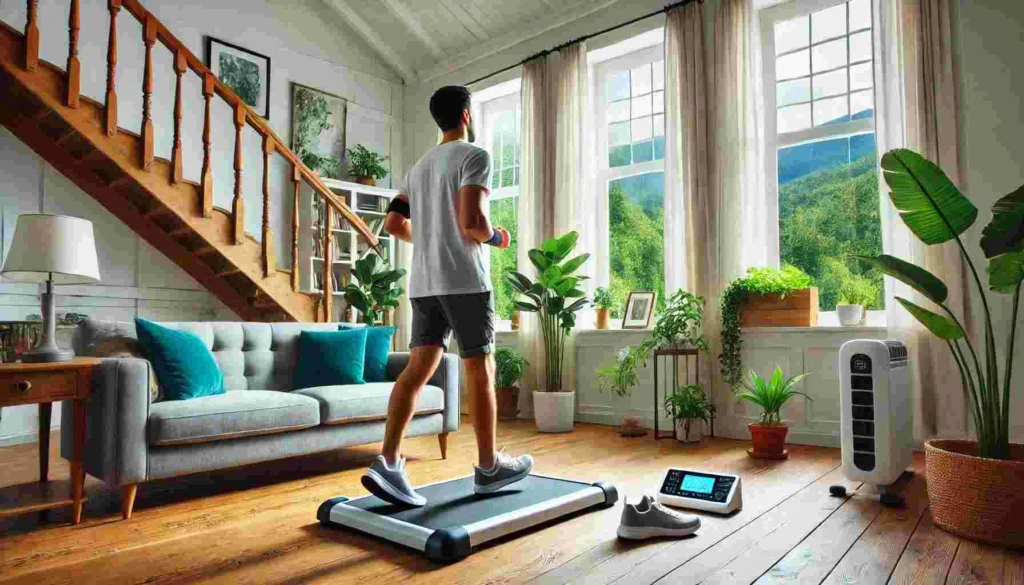
Indoor Walking Workouts: Achieving 10,000 Steps Without Leaving Home
Introduction: The Power of Indoor Walking
Walking is one of the simplest yet most effective exercises for maintaining overall health. The widely recommended goal of 10,000 steps a day can significantly enhance cardiovascular health, boost mood, and support weight management. But what if stepping outside isn’t an option? Whether due to weather, time constraints, or personal preference, achieving your step goal indoors is entirely possible—and surprisingly fun.
This blog post will guide you through engaging indoor walking workouts and strategies to help you hit 10,000 steps daily without ever stepping out of your front door.
Benefits of Indoor Walking Workouts
1. Convenient and Time-Efficient
One of the biggest advantages of indoor walking is its convenience. No special equipment, gym memberships, or even outdoor gear is needed. You can fit a walking workout into your day at any time, whether during a quick break from work or while watching your favorite TV show.
2. Weatherproof Exercise
Rain, snow, or extreme heat won’t interrupt your fitness goals. Indoor walking ensures that your workout schedule remains consistent year-round, regardless of external conditions.
3. Versatile for All Fitness Levels
Indoor walking workouts are easily adaptable to any fitness level. Whether you’re a beginner taking your first steps toward fitness or a seasoned walker looking to increase intensity, there’s an option for everyone.
4. A Safe Option for Many
For those with safety concerns or mobility limitations that make outdoor walking challenging, indoor workouts provide a controlled and secure environment.
How to Get Started with Indoor Walking Workouts
1. Plan Your Walking Space
Choose a dedicated space in your home for walking. It can be a long hallway, a spacious room, or even your living room. Clear away clutter to avoid tripping hazards.
2. Set Realistic Goals
While 10,000 steps is the ultimate target, start with achievable milestones. For example, aim for 5,000 steps initially and gradually increase as your stamina improves.
3. Use a Step Tracker
Wearable devices like fitness trackers or pedometers help you monitor your progress. They can provide real-time feedback and keep you motivated to reach your daily step goal.
4. Incorporate Fun Elements
To make indoor walking enjoyable, add elements like music, podcasts, or walking in sync with TV shows. Many streaming platforms also offer guided walking workout videos that combine walking with light aerobics for added variety.
Types of Indoor Walking Workouts
1. Simple Step Marches
A basic step march is an excellent starting point. Stand in place and march, swinging your arms for added intensity. Gradually increase your pace to elevate your heart rate.
2. Walking Routines with Light Weights
Add light dumbbells to your walking routine to engage your upper body. Combine steps with simple arm exercises like bicep curls or shoulder presses for a full-body workout.
3. Interval Walking
Alternate between slow, steady walking and bursts of fast walking. This interval style not only keeps the workout interesting but also boosts calorie burn.
4. Walking Up Stairs
If you have stairs at home, incorporate them into your routine. Walking up and down stairs is a powerful way to engage multiple muscle groups and increase the intensity of your workout.
5. Dance Walking
Add flair to your walking by incorporating dance movements. This fun and energetic workout style keeps your steps dynamic and engaging.
Tracking Progress and Staying Motivated
1. Break It Down
Reaching 10,000 steps might seem daunting, but breaking it into smaller chunks makes it manageable. For instance, aim for 2,000 steps in the morning, afternoon, and evening.
2. Celebrate Milestones
Celebrate small achievements to maintain motivation. Reaching 5,000 steps consistently? Reward yourself with something enjoyable, like a new fitness accessory or a relaxing bath.
3. Create a Walking Playlist
Music is a powerful motivator. Create a playlist with upbeat songs that match your walking pace to keep you energized throughout your workout.
1. Add Resistance for More Intensity
If you’ve mastered basic indoor walking, introducing resistance can elevate your workout. Resistance bands, ankle weights, or hand-held weights can increase the effort required for each step. This not only boosts calorie burn but also helps build muscle strength.
2. Try Walking Workouts with HIIT Elements
High-Intensity Interval Training (HIIT) can be incorporated into your walking routine for a more challenging session. Alternate between periods of brisk walking and slower-paced recovery. For example, walk at a fast pace for 1 minute, then slow down for 2 minutes, repeating the cycle for 20-30 minutes.
3. Integrate Full-Body Movements
Combine walking with bodyweight exercises like squats, lunges, or arm circles. For example:
- Walk in place for 2 minutes.
- Stop to perform 10 squats.
- Resume walking and add arm movements, such as bicep curls or overhead stretches.
This approach keeps your body engaged and enhances overall fitness.
Indoor Walking Routines for Specific Goals
1. Weight Loss Goals
If weight loss is your primary objective, focus on maintaining a brisk pace and incorporating longer walking sessions. Aim for at least 30-60 minutes of indoor walking daily, divided into multiple sessions if needed. Combine this with calorie-burning intervals or walking up stairs to intensify the workout.
2. Cardio Health
To improve cardiovascular health, focus on consistency and endurance. Walking in place for extended periods, with occasional speed bursts, can keep your heart rate elevated. Incorporating movements like side steps or grapevines can make your cardio sessions more dynamic.
3. Stress Relief
Walking can be a meditative activity when done mindfully. Slow your pace, focus on your breath, and try rhythmic walking patterns to calm the mind. Pair your workout with soothing music or a guided meditation for added relaxation benefits.
4. Building Stamina
Gradually increase the duration of your walking sessions each week. Start with shorter sessions of 10-15 minutes, then extend them by 5-minute increments. Consistent progress will build stamina over time.
Overcoming Common Challenges of Indoor Walking
1. Limited Space
A small space doesn’t have to hinder your walking goals. Opt for workouts that incorporate compact movements, like step marches or side shuffles. You can also walk in place if moving around is restricted.
2. Staying Motivated Indoors
Without changing scenery, it’s easy to lose interest in indoor walking. Combat boredom by:
- Following virtual walking tours.
- Setting daily step challenges for yourself.
- Inviting a family member or friend to join your routine.
3. Managing Foot and Joint Discomfort
Walking indoors on hard surfaces can sometimes lead to discomfort. To avoid this:
- Invest in good-quality walking shoes with ample cushioning.
- Use a soft exercise mat for any stationary walking movements.
- Stretch before and after your workout to ease joint stiffness.
Indoor Walking and Technology: Tools to Keep You on Track
1. Step-Tracking Apps
Using apps like Google Fit or Apple Health can provide valuable insights into your progress. These apps help you monitor your steps, set daily goals, and analyze trends over time.
2. Fitness Streaming Services
Many online platforms offer guided indoor walking workouts. From low-impact routines to advanced challenges, these services provide structured sessions that keep you engaged.
3. Smartwatches and Wearables
Smartwatches and fitness bands are excellent for tracking metrics like steps, distance, and calories burned. They can also prompt you to stay active with gentle reminders throughout the day.
Incorporating Indoor Walking into Your Lifestyle
1. Walk While Doing Other Activities
Combine walking with other daily tasks, like:
- Talking on the phone.
- Watching TV.
- Listening to audiobooks or podcasts.
This multitasking approach ensures you stay active without requiring dedicated time for exercise.
2. Set a Routine
Incorporate indoor walking into your daily schedule to make it a habit. For example:
- Start your morning with a 10-minute walk.
- Take a walking break during lunch.
- End your day with a relaxing walk before bedtime.
3. Involve Your Family
Walking is a great way to engage the whole family in physical activity. Turn it into a game or a challenge to make it fun for everyone.
Tracking Progress and Maintaining Momentum
1. Keep a Walking Journal
Documenting your steps, durations, and milestones can help you stay motivated. It’s also a great way to track your progress over weeks and months.
2. Gradual Goal Setting
Set incremental goals to keep the process rewarding. For instance, if you’re starting at 6,000 steps a day, aim to add 500 steps weekly until you reach 10,000.
3. Reward Yourself
Celebrate your achievements. For instance, treat yourself to a new pair of walking shoes or a fitness gadget after reaching a significant milestone.
1. Create a Sustainable Walking Schedule
Consistency is key to maintaining an effective walking routine. Craft a schedule that aligns with your daily activities and energy levels. For example:
- Morning Walk: Energize your day with a quick 10–15-minute session.
- Midday Walk: Take a break during lunch to get in another 10–20 minutes.
- Evening Walk: Wind down your day with a relaxing 20–30-minute walk.
A consistent schedule helps integrate walking as a natural part of your day rather than a chore.
Avoiding Plateaus in Your Indoor Walking Routine
1. Increase Your Step Count Gradually
Once you comfortably reach 10,000 steps a day, push your limits by setting higher goals. Start by adding 500–1,000 extra steps weekly to keep challenging your body.
2. Change Up Your Walking Styles
Prevent boredom by varying your walking techniques:
- Side Steps: Move laterally to engage different muscle groups.
- Backwards Walking: Improve balance and coordination while targeting underused muscles.
- Power Walking: Add intensity with faster-paced steps and exaggerated arm movements.
3. Use Props for Added Variety
Incorporate props like:
- Resistance bands for leg and arm movements.
- A balance board to improve core strength and stability.
- A treadmill (if available) to adjust speed and incline for a dynamic workout.
Crafting Indoor Walking Challenges
1. Weekly Step Goals
Set a weekly target and aim to surpass it. For instance, strive for 70,000 steps a week, averaging 10,000 steps daily.
2. Time-Based Challenges
Dedicate specific durations to walking:
- 15-Minute Challenge: Count how many steps you can achieve in 15 minutes.
- Hour-Long Walks: Commit to a full hour of steady walking once or twice a week.
3. Themed Walking Days
Introduce themes to your walks:
- Cardio Mondays: Focus on fast-paced walking.
- Strength Thursdays: Combine walking with bodyweight exercises.
- Family Sundays: Involve the entire household in a group walk.
Enhancing the Indoor Walking Experience
1. Create a Walking-Friendly Environment
A comfortable and engaging environment enhances your indoor walking sessions. Consider:
- Music and Ambience: Play upbeat music or set up a calming playlist depending on your mood.
- Lighting: Ensure your space is well-lit to promote a positive atmosphere.
- Visual Distractions: Place your treadmill near a window or use a TV for entertainment.
2. Reward Yourself with Walk Breaks
Transform mundane tasks into walk opportunities. For instance:
- Walk for 5 minutes before responding to emails.
- Take a brief walk break after completing a household chore.
Combining Indoor Walking with Other Exercises
1. Yoga and Walking
Begin or end your walking session with yoga stretches to improve flexibility and reduce muscle tension. Poses like the downward dog or cat-cow stretch pair well with walking.
2. Strength Training Intervals
Alternate between walking and bodyweight exercises like:
- Push-ups.
- Lunges.
- Planks.
This fusion builds strength while keeping your cardio in check.
3. Dance and Walk
Add dance moves into your walking routine. A few minutes of groovy steps between walking sessions keep workouts lively and enjoyable.
Indoor Walking for All Ages
1. Tailoring for Seniors
Indoor walking is a low-impact, joint-friendly exercise suitable for seniors. To enhance safety and comfort:
- Use a supportive pair of shoes.
- Walk on non-slip surfaces.
- Incorporate light chair-assisted exercises if needed.
2. Engaging Kids in Walking Workouts
Make walking fun for kids with creative activities:
- Play step-counting games.
- Challenge them to walk in different styles (e.g., hopping, skipping).
- Introduce dance-walking routines to keep them entertained.
Monitoring and Adjusting Your Progress
1. Regularly Assess Your Performance
Keep track of key metrics like:
- Daily step count.
- Calories burned.
- Time spent walking.
Use this data to identify patterns and areas for improvement.
2. Set Long-Term Goals
Define long-term milestones, such as completing a virtual walking challenge or achieving a monthly step goal. These objectives provide direction and sustained motivation.
3. Adjust for Life Changes
Life events like work schedules or travel may disrupt your routine. Adapt by:
- Shortening session durations during busy periods.
- Using hotel hallways or rooms for walking while traveling.
- Scheduling walking breaks in your calendar to stay consistent.
The Holistic Benefits of Indoor Walking
1. Improved Mental Clarity
Walking stimulates blood flow to the brain, enhancing focus, memory, and decision-making skills. Incorporating mindfulness into your walks amplifies these cognitive benefits.
2. Enhanced Mood
Walking triggers the release of endorphins, reducing stress and boosting happiness. Pairing your routine with uplifting music or engaging podcasts further uplifts your mood.
3. Better Sleep
Consistent indoor walking promotes a healthy sleep-wake cycle. Evening walks, in particular, can help relax your body and mind, paving the way for restful sleep.



